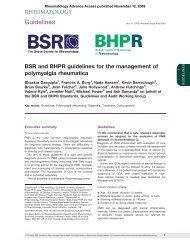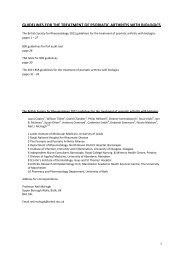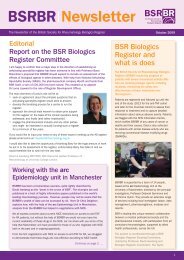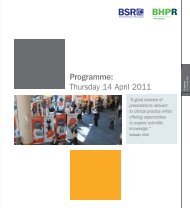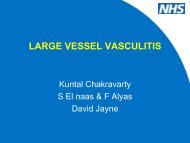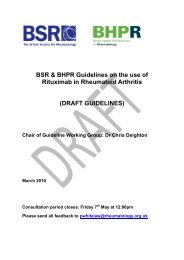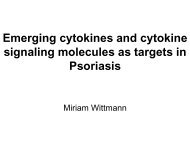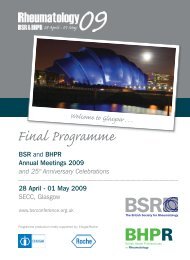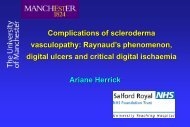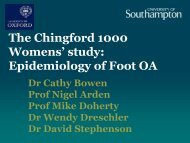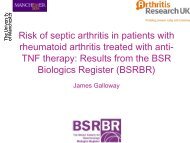Genome wide association studies in inflammatory myopathy and
Genome wide association studies in inflammatory myopathy and
Genome wide association studies in inflammatory myopathy and
You also want an ePaper? Increase the reach of your titles
YUMPU automatically turns print PDFs into web optimized ePapers that Google loves.
IIM GWAS reveals genetic risk factors shared<br />
with other autoimmune diseases (AID).<br />
Robert G Cooper, on behalf of UK MYONET & MYOGEN<br />
Salford Royal Foundation Trust & University of Manchester
• None<br />
Conflicts of Interest
Polymyositis<br />
Dermatomyositis<br />
Idiopathic<br />
Inflammatory<br />
Myopathy<br />
Malignancy<br />
Myositis-CTD<br />
overlap<br />
Juvenile<br />
dermatomyositis
Background<br />
• IIM rema<strong>in</strong> a therapeutic challenge –<br />
1) Often refractory<br />
2) Disease mechanisms poorly understood<br />
• Mechanistic research difficult, as IIM so rare:<br />
~ 1 new case per UK rheumatologist every 4-5<br />
yrs.
Early genetics - HLA region
Log OR & 95% CI<br />
Myositis C<strong>and</strong>idate Gene Studies Pre-2000<br />
HLA-DRB1*0301<br />
HLA-DQA1*0501<br />
= US<br />
Caucasian<br />
= Korean<br />
Rider LG et al. Arthritis Rheum 1999;42:1285-1290
Classification of myositis accord<strong>in</strong>g to auto-Abs ?<br />
•Interstitial lung disease<br />
•Arthritis<br />
•Mechanic’s h<strong>and</strong>s<br />
•Acute severe muscle<br />
weakness<br />
•Myalgias<br />
•V-sign rash<br />
•Shawl-sign rash<br />
•Cuticular overgrowth<br />
Courtesy of Prof FW Miller 1998
Methodological Issues <strong>in</strong> Pre-2000<br />
Studies<br />
• Small sample size<br />
• Ethnic heterogeneity<br />
– Caucasian, Jewish & Hispanic patients grouped<br />
together to ga<strong>in</strong> statistical power <strong>in</strong> case:control<br />
comparisons.<br />
• Sub-type heterogeneity<br />
– DM, PM, JDM & IBM pooled to ga<strong>in</strong> statistical power.<br />
– Ab subgroups
UK-Adult Onset Myositis Immunogenetic<br />
Collaboration (AOMIC) – RGC/WER0<br />
• Only Caucasians studied<br />
• Phenotype details, serum <strong>and</strong><br />
DNA<br />
• Myositis probable/def<strong>in</strong>ite<br />
accord<strong>in</strong>g to Bohan/Peter<br />
• PM (n=121)<br />
• DM (n=110)<br />
• CTD/overlap (n=71)<br />
• Controls (n=537)<br />
• [2000 – 2004 ~230 cases]
Aims of AOMIC<br />
• Immediate - To recruit ethnically homogeneous<br />
(Caucasian) myositis subtype cohorts of<br />
sufficient size to allow between-subtype genetic<br />
comparisons.<br />
• Long-term - To elucidate aetiopathogical<br />
mechanisms capable of facilitat<strong>in</strong>g future<br />
therapeutic developments.
log OR & 95% confidence <strong>in</strong>terval<br />
HLA class II <strong>association</strong>s <strong>in</strong> 230 UK<br />
PM/DM cases<br />
10<br />
6<br />
4<br />
=PM<br />
=DM<br />
2<br />
1<br />
.6<br />
.4<br />
.2<br />
.1<br />
DRB1*03<br />
DRB1*07<br />
DQA1*05<br />
DQB1*02
LD - HLA class II haplotypes<br />
DRB1*03-DQA1*05-DQB1*02<br />
DRB1*07-DQA1*02-DQB1*02<br />
PM DM<br />
anti-synthetase<br />
ILD<br />
anti-Jo-1/PM-Scl<br />
DM-specific<br />
anti-synthetase<br />
ILD<br />
anti-Mi-2
Myositis-specific autoantibodies<br />
Myositis specific autoantibodies<br />
Anti-synthetase syndrome<br />
Fever<br />
Raynauds<br />
Lung fibrosis<br />
+/- DM rash<br />
Myositis<br />
Arthropathy<br />
Mechanics h<strong>and</strong>s<br />
Necrotis<strong>in</strong>g<br />
<strong>myopathy</strong><br />
High CK<br />
Treatment<br />
resistant<br />
Cl<strong>in</strong>ical phenotypes <strong>in</strong> adults <strong>and</strong> children<br />
Amyopathic<br />
dermatomyositis<br />
Rash s<strong>in</strong>e myositis<br />
Hypomyopathic<br />
Rash precedes myositis<br />
Dermatomyositis<br />
Rash<br />
Malignancy<br />
Calc<strong>in</strong>osis/vasculitis<br />
(children)<br />
Jo-1<br />
Anti-SRP<br />
Anti-SAE<br />
Anti-NXP-2<br />
Zo<br />
EJ<br />
PL-7<br />
Anti-synthetases<br />
YRS<br />
Anti-200/100<br />
Anti-MDA-5<br />
Anti-p155/140<br />
Anti-Mi-2<br />
KS<br />
OJ<br />
PL-12<br />
Slide adapted from Dr Gunawardena
So, how to go about a GWAS <strong>in</strong> a<br />
condition as heterogeneous as<br />
myositis?
Dermatomyositis (DM)<br />
• Myositis with the pathognomonic Heliotrope rash or<br />
Gottron’s papules<br />
• Adult-onset <strong>and</strong> juvenile-onset (age
Characteristic DM Histology
GWAS approaches 1<br />
• MYOGEN (UK/EU/US), an <strong>in</strong>ternational myositis<br />
genetics consortium established to study the genetics of<br />
myositis.<br />
• Objectives of the first MYOGEN study were to identify<br />
new genetic risk or protective factors for DM, <strong>and</strong> to<br />
assess possible genetic overlaps with other AID.<br />
• GWAS performed on subjects of European ancestry<br />
meet<strong>in</strong>g probable or def<strong>in</strong>ite Bohan <strong>and</strong> Peter criteria for<br />
DM, us<strong>in</strong>g Illum<strong>in</strong>a platforms.<br />
• Subjects studied were 1178 DM cases (705 with adult<br />
DM <strong>and</strong> 473 with juvenile DM) who were compared to<br />
4724 geographically- <strong>and</strong> race-matched controls.
GWAS approaches (2)<br />
• Further assessments on the DM GWAS data for 140<br />
non-MHC SNPs previously associated with AID (RA,<br />
SLE, Crohn’s, type 1 Diabetes & Multiple Sclerosis).<br />
18
Covariate 2<br />
Multidimensional scal<strong>in</strong>g analysis of<br />
European PM/DM GWAS data<br />
MDS Dimensions 1 <strong>and</strong> 2<br />
0.015<br />
0.01<br />
0.005<br />
0<br />
-0.02 -0.01 0 0.01 0.02 0.03 0.04 0.05<br />
Covariate 1<br />
-0.005<br />
Czech (117)<br />
-0.01<br />
Hungary (89)<br />
Netherl<strong>and</strong>s (27)<br />
-0.015<br />
Sweden (79)<br />
UK (319)<br />
-0.02<br />
-0.025
Covariate 2<br />
Multidimensional scal<strong>in</strong>g analysis of European<br />
PM/DM GWAS data – NARAC controls<br />
MDS dimension 1 <strong>and</strong> 2<br />
0.02<br />
0.015<br />
0.01<br />
0.005<br />
0<br />
-0.02 -0.01 0 0.01 0.02 0.03 0.04 0.05<br />
-0.005<br />
Covariate 1<br />
-0.01<br />
-0.015<br />
-0.02<br />
-0.025<br />
-0.03<br />
Cases (631) Controls (1140)
Populations Studied<br />
Cases<br />
Controls<br />
Population<br />
Sample<br />
Size<br />
Adult DM<br />
Women<br />
(%)<br />
Juvenile DM<br />
Sample<br />
Size<br />
Women<br />
(%)<br />
Sample<br />
Size<br />
Women<br />
(%)<br />
No. of<br />
Successfully<br />
genotyped<br />
SNPs<br />
Covariates<br />
Genomic<br />
<strong>in</strong>flation<br />
factor (λ)<br />
Czech/<br />
Hungarian<br />
178 70.80% 23 78.30% 256 57.40% 242530<br />
Population<br />
Structure<br />
1.01<br />
Spanish 43 81.40% 4 50% 259 65.60% 242871<br />
Population<br />
Structure<br />
1.009<br />
Swedish/<br />
Dutch<br />
48 68.80% 4 75% 642 72.40% 242644<br />
Population<br />
Structure<br />
1.021<br />
UK 149 65.80% 159 70.40% 2415 47.80% 236039 None 1<br />
USA 287 76.00% 283 69.60% 1152 70.80% 237155<br />
Population<br />
Structure<br />
1.073<br />
Metaanalysis<br />
705 72.4% 473 70.2% 4724 58.2% 241502 None 1.043<br />
21
Manhattan Plot of DM GWAS Associations<br />
Show<strong>in</strong>g a Major MHC Signal<br />
80 genotyped SNPs across the MHC region, but no other SNPs showed<br />
Whole genome significance (orange l<strong>in</strong>e)<br />
22
Published GWAS loci for AID –<br />
Associations with DM (P ≤ 0.015)<br />
Gene<br />
Chr / Position<br />
SNP Marker<br />
<strong>in</strong> Dataset<br />
SNP Marker<br />
not <strong>in</strong> Dataset<br />
: LD to<br />
Dataset<br />
Marker<br />
Uncorr<br />
P<br />
B lymphoid tyros<strong>in</strong>e k<strong>in</strong>ase: BLK 8 / 11381382 rs2736340 0.000065<br />
Chemok<strong>in</strong>e (C-C motif) lig<strong>and</strong> 21:<br />
CCL21<br />
9 / 34727828 rs2492358 rs951005:1.0 0.000209<br />
CCL21 9 / 34733681 rs951005 0.00031<br />
Prote<strong>in</strong> tyros<strong>in</strong>e phosphatase nonreceptor<br />
type 2: PTPN2<br />
Signal transducer <strong>and</strong> activator of<br />
transcription 4: STAT4<br />
18 / 12799340 rs1893217 0.00289<br />
2 / 191672878 rs7574865 0.00496<br />
Interleuk<strong>in</strong>-2 receptor alpha: IL2RA 10 / 6146272 rs7072793 rs706778:0.935 0.00727<br />
ER-resident transmembrane prote<strong>in</strong>:<br />
ORMDL3<br />
17 / 35319766 rs2290400 0.00997<br />
SH2B adapter prote<strong>in</strong> 3: SH2B3 12 / 110492139 rs653178 rs3184504:1.0 0.0138<br />
SH2B3 12 / 110368991 rs3184504 0.0149<br />
Interferon regulatory factor 5: IRF5 7 / 128381419 rs10488631 0.015<br />
All of these <strong>association</strong>s are novel <strong>in</strong> myositis - No significant differences <strong>in</strong> these loci<br />
were noted between males <strong>and</strong> females or between adult <strong>and</strong> juvenile DM cases<br />
23
QQ plots show<strong>in</strong>g published GWAS loci<br />
for AID with DM (Left) that are not seen <strong>in</strong><br />
lung cancer (Right)<br />
24
• The first GWAS <strong>in</strong> DM confirmed a strong signal <strong>in</strong> the MHC region as<br />
expected, but no non-MHC SNPs met GWAS significance <strong>in</strong> this 1178 patient<br />
sample.<br />
• However, assessment of 140 non-MHC SNPs associated with AID <strong>in</strong>dicates<br />
that DM shares many genetic features with these other diseases <strong>and</strong> suggests<br />
the presence of additional novel risk loci that require further study <strong>and</strong><br />
confirmation <strong>in</strong> DM.<br />
• B lymphoid tyros<strong>in</strong>e k<strong>in</strong>ase: BLK<br />
Summary<br />
• Chemok<strong>in</strong>e (C-C motif) lig<strong>and</strong> 21: CCL21<br />
• Prote<strong>in</strong> tyros<strong>in</strong>e phosphatase non-receptor type 2: PTPN2<br />
• Signal transducer <strong>and</strong> activator of transcription 4: STAT4<br />
• Interleuk<strong>in</strong>-2 receptor alpha: IL2RA<br />
• ER-resident transmembrane prote<strong>in</strong>: ORMDL3<br />
• SH2B adapter prote<strong>in</strong> 3: SH2B3<br />
• Interferon regulatory factor 5: IRF5<br />
25
Next Steps<br />
• Immunochip analysis currently be<strong>in</strong>g undertaken <strong>in</strong> DM.<br />
• Generate larger cohorts for DM, PM <strong>and</strong> the rarer MSAassociated<br />
IIM subgroups.<br />
• So, recruit, recruit, recruit!!!<br />
26
Total number of participants recruited each year<br />
Yearly accrual figures s<strong>in</strong>ce AOMIC began <strong>in</strong> 2000, became UK<br />
MYONET <strong>in</strong> 2008/9 (current recruitment total 922)<br />
250<br />
200<br />
150<br />
100<br />
50<br />
0<br />
1 2 3 4 5 6 7 8 9 10 11 12<br />
Years
MYOGEN Members<br />
• Robert Cooper - The University of Manchester Rheumatic Diseases Centre, Salford, UK – on<br />
behalf of UK MYONET<br />
• Jiri Vencovsky - Institute of Rheumatology, Prague, Czech Republic<br />
• Kati Danko - University of Debrecen, Debrecen, Hungary<br />
• Fred Miller, Lisa Rider, Terrance O’Hanlon - NIEHS, NIH, Bethesda, MD<br />
• Lucy Wedderburn, David Isenberg – Univ. College London, London, UK<br />
• Ingrid Lundberg, Leonid Padyukov - Karol<strong>in</strong>ska Inset, Stockholm, Sweden<br />
• Lauren Pachman - Children’s Memorial Research Ctr., Chicago, IL<br />
• Ann Reed, Steve Ytterberg - Mayo Cl<strong>in</strong>ic, Rochester, MN<br />
• Albert Selva O’Callaghan - Val d 'Hebron General Hospital, Barcelona, Spa<strong>in</strong><br />
• Tim Radstake - Nijmegen Ctr. Mol. Life Sciences, Nijmegen, Netherl<strong>and</strong>s<br />
● Paul Plotz, Mark Gourley - NIAMS, NIH, Bethesda, MD 28
• Hector Ch<strong>in</strong>oy - Musculoskeletal Unit, Manchester HSC, University of<br />
Manchester, Manchester, UK<br />
• Jan<strong>in</strong>e Lamb, William Ollier - Centre for Integrated Genomic Med Res,<br />
Manchester Academic HSC, University of Manchester, Manchester, UK<br />
• Bo Peng, Wei Chen, Paul Scheet, Chris Amos - MD Anderson Cancer<br />
Center, Houston, TX<br />
• Annette Lee, Peter Gregersen - Fe<strong>in</strong>ste<strong>in</strong> Institute for Medical Research,<br />
Manhasset, NY<br />
• MYOGEN UK Contributors<br />
MYOGEN Members (cont.)<br />
– AOMIC/UK MYONET contributors (60+) – Coords. RGC/WERO<br />
– UK JDM Research Group – Coord. Lucy Wedderburn<br />
• SPONSORS – NIEHS NIH, EU AutoCure Myositis, UK Myositis Support<br />
Group, ARUK, Cure Juvenile Myositis Association, European Science<br />
Foundation (ESF) <strong>and</strong> the Wellcome Trust<br />
29




